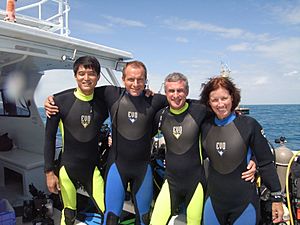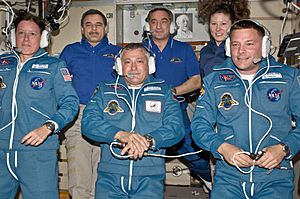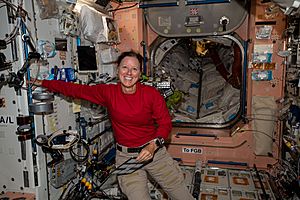Shannon Walker facts for kids
Quick facts for kids
Shannon Walker
|
|
|---|---|

Walker in 2020
|
|
| Born | June 4, 1965 |
| Space career | |
| NASA astronaut | |
|
Time in space
|
330d 13h 40m |
| Selection | NASA Group 19 (2004) |
| Missions | Soyuz TMA-19 (Expedition 24/25) SpaceX Crew-1 (Expedition 64/65) |
|
Mission insignia
|
|
| Retirement | July 10, 2025 |
Shannon Walker (born June 4, 1965) is an American physicist and a former NASA astronaut. She was chosen by NASA in 2004.
Shannon Walker first flew into space on June 25, 2010. She traveled aboard the Soyuz TMA-19 spacecraft. She spent over 163 days living and working in space.
She went back to space for her second long mission on November 15, 2020. This time, she flew on SpaceX Crew-1. This was the first regular flight of SpaceX's Crew Dragon spaceship.
Contents
Becoming an Astronaut: Shannon Walker's Journey
Early Life and School Days
Shannon Walker was born in Houston, Texas. She finished high school at Westbury High School in 1983.
She then went to Rice University in Texas. There, she studied physics and earned her first degree in 1987.
Later that year, Walker started working for Rockwell Space Operations Company. She was a robotics flight controller for the Space Shuttle program at the Johnson Space Center. She helped control several Space Shuttle missions from the ground.
From 1990 to 1993, Walker went back to school. She studied how the sun's energy affects the atmosphere of Venus. She earned her Master's and PhD degrees in Space Physics from Rice University.
In 1995, she joined NASA as a civil servant. She began working on the International Space Station (ISS) Program. She helped design and build the robot parts for the Space Station.
In 1999, Walker moved to Moscow, Russia. She worked with the Russian Space Agency on the ISS. She helped solve problems with the station's electronic systems. She returned to Houston in 2000.
Training to Be an Astronaut
In May 2004, NASA chose Shannon Walker to become an astronaut. She was part of the 19th group of astronauts.
By February 2006, she finished her astronaut training. This training included learning about space systems. She also had flight training in a T-38 Talon jet. She learned survival skills for water and wilderness. After this training, she was ready for space missions.
In September 2011, NASA announced that Walker would lead the NEEMO 15 mission. This mission took place in an underwater laboratory called Aquarius. It was like living on the space station, but underwater. The mission started on October 20, 2011. Walker and her crew became "aquanauts" after spending a day underwater. The mission ended early on October 26 because of a hurricane.
Shannon Walker's Space Missions
First Space Mission: Expedition 24/25
Shannon Walker was chosen for the main crew of Expedition 24/25. An "Expedition" is a long stay on the International Space Station.
On June 15, 2010, Walker launched into space. She was with NASA astronaut Douglas H. Wheelock and Russian cosmonaut Fyodor Yurchikhin. Two days later, they arrived at the ISS. They docked their Soyuz spacecraft to the Zvezda module. They officially joined the Expedition 24 crew.
During Expedition 24, Walker and her crew moved their Soyuz spacecraft. They flew it from the Zvezda module to the new Rassvet module. They were the first crew to dock with this new part of the station.
When the previous crew left, Walker and her two crewmates became part of Expedition 25. More crew members soon joined them.
On November 26, 2010, Walker, Wheelock, and Yurchikin left the ISS. They returned to Earth in their Soyuz spacecraft. They landed safely in Kazakhstan.
Second Space Mission: Expedition 64/65
On March 31, 2020, NASA announced Walker's second spaceflight. She would fly on USCV-1, the first regular flight of SpaceX's Crew Dragon spacecraft. This was part of the Commercial Crew Program.
Walker launched on November 15, 2020. She and her three crewmates spent 167 days on the ISS. They were part of Expedition 64/65.
The crew docked with the ISS in November. They joined Russian cosmonauts Sergey Ryzhikov and Sergey Kud-Sverchkov, and NASA astronaut Kathleen Rubins. When some of the crew left, Walker and her three crewmates became part of Expedition 65. Walker took command of the expedition. She was the third woman to command the ISS. She served as commander for about 11 days.
Shannon Walker's Retirement
Shannon Walker retired from NASA on July 10, 2025. She had a long and successful career. She worked for the government for over 30 years. She was a NASA astronaut for more than 21 years.
During her time at NASA, Walker flew on two long space missions. She spent a total of 330 days in space. Her work helped with many science projects and new technology tests on the International Space Station.
In her later years at NASA, she held important leadership jobs. She was the deputy chief of the Astronaut Office. In this role, she helped manage astronaut training and missions. Her retirement was announced in July 2025. Her career was known for her technical skills, space achievements, and for guiding other astronauts.
Awards and Recognitions
Shannon Walker has received many awards. These include the Goethe Institute Scholarship and the Rice Fellowship. She also earned several Group Achievement Awards for her work on the International Space Station. She received a Space Flight Awareness Award for her contributions to the ISS Program.
She is a member of the Aircraft Owners and Pilots Association (AOPA). She also belongs to The Ninety-Nines International Organization of Women Pilots.
In 2022, a SpaceX ship was renamed Shannon in her honor. This ship helps recover the Dragon spacecraft after missions.
The Dr. Shannon Walker Library in Houston, Texas, is also named after her.
Personal Life
Shannon Walker is married to Andy Thomas. He is a retired NASA astronaut who was born in Australia.
In her free time, Walker enjoys cooking, playing soccer, running, and lifting weights. She also likes flying, camping, and traveling.
See also
 In Spanish: Shannon Walker para niños
In Spanish: Shannon Walker para niños





